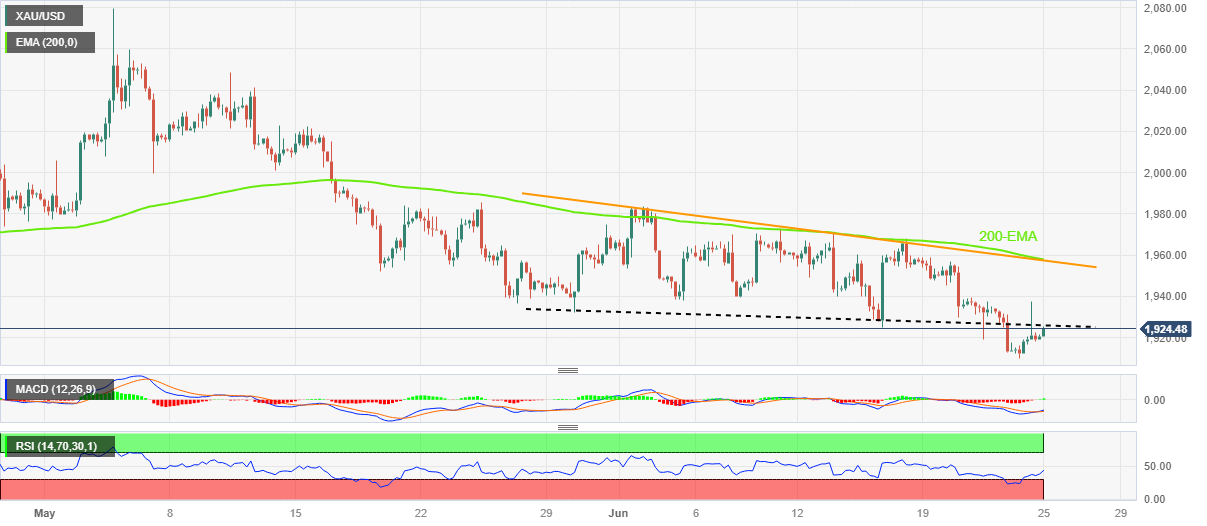- Gold Price licks its wounds at the lowest levels in 3.5 months as risk-aversion amplifies.
- Geopolitical fears join hawkish Fed bets, growth concerns to weigh on XAU/USD price.
- Gold Price drops as mixed United States data versus downbeat figures from elsewhere underpin US Dollar demand.
- US inflation clues eyed for clear directions, multiple central bankers’ speeches also important to watch.
Gold Price (XAU/USD) prints corrective bounce from the lowest levels since early March, marked the previous week, as traders consolidate the previous week’s loss, the heaviest since latest January amid mixed concerns about the global growth and geopolitics. Also allowing the Gold Price to recover to $1,923 is the consolidation ahead of this week’s United States inflation clues and speech from various central bankers including those from the Federal Reserve (Fed), European Central Bank (ECB) and the Bank of England (BoE).
Gold Price stays on the bear’s radar amid growth fears
Gold Price remains on the back foot despite the latest rebound as fears of global economic slowdown, unveiled through the higher rates and sluggish statistics, underpin the US Dollar’s haven demand.
During the last week, multiple central banks from the UK, Europe, Turkiye and Switzerland have announced rate hikes and bolstered fears of higher rates when the economies aren’t performing well.
That said, Friday’s preliminary readings of the Purchasing Managers Indexes (PMIs) for the key economies were mostly down outside the US. The same allowed the US Dollar Index (DXY) to have additional strength and cheer the risk-off mood, which in turn exert downside pressure on the Gold Price.
On Friday, US S&P Global PMIs for June came in mixed as the Manufacturing PMI dropped to 46.3 from 48.4 prior, versus 48.5 expected, whereas the Services PMI improved to 54.1 from 54.0 expected despite being lesser than the 54.9 previous monthly figure. With this, the Composite PMI declined to 53.0 versus 54.4 market forecsts and 54.3 prior.
Following the data, Chris Williamson, Chief Business Economist at S&P Global Market Intelligence said, “Any further rate hikes will of course have a further dampening effect on this sector (services) which is especially susceptible to changes in borrowing costs.”
Federal Reserve Bank of San Francisco President Mary Daly told Reuters on Friday that two more interest rate increases this year would be a “very reasonable projection.”
Elsewhere, the preliminary readings of Germany’s HCOB PMIs for June were downbeat. That said, the Manufacturing gauge worsened to 41.0 versus 43.5 expected and 43.2 prior whereas Services PMI also dropped to 54.1 from 57.2 previous readings and 56.2 market forecasts. With this, the Composite PMI dropped to 50.8 from 53.9 prior and 53.5 analysts’ estimations. On the same line, Eurozone HCOB PMIs were also downbeat as the headlines Manufacturing PMI dropped to 43.6 from 44.8 expected and prior while the Services PMI dropped to 52.4 versus 54.5 market forecasts and 55.1 prior. Further, the Composite PMI declined to 50.3 compared to 52.5 expected and 52.8 prior.
Furthermore, the UK’s S&P Global/CIPS PMIs for June came in downbeat as the Manufacturing PMI dropped to 46.2 versus 46.8 expected and 47.1 prior whereas the Services PMI also eased to 53.7 from 54.8 market forecasts and 55.2 previous readings. With this, the Composite PMI came in as 52.8 versus 53.6 market forecasts and 54.0 prior.
Hence, the PMIs were mostly downbeat and backed fears of recession but the US policymakers appear hawkish and witness less disappointment from the data. With this, the Gold Price has to bear the burden of the upbeat US Dollar.
Geopolitical fears also weigh on XAU/USD despite China optimism
Apart from the growth concerns and hawkish Federal Reserve expectations, the Gold Price also bear the burden of the geopolitical concerns in Russia. In this regard, Reuters said, “Heavily armed Russian mercenaries withdrew from the southern Russian city of Rostov under a deal that halted their rapid advance on Moscow but raised questions on Sunday about President Vladimir Putin’s grip on power.”
Elsewhere, Ning Jizhe, deputy head of the economic committee of the Chinese People’s Political Consultative Conference (CPPCC) and a former vice head of the National Development and Reform Commission (NDRC) flagged concerns of sooner stimulus from China and put a floor under the Gold Price. “China needs to step up measures as soon as possible to bolster a faltering post-COVID recovery in the world’s second-largest economy,” said China’s Ning Jizhe per Reuters.
Against this backdrop, Wall Street benchmarks drop and the US Treasury bond yields grind higher, which in turn put a floor under the US Dollar and exert downside pressure on the Gold Price.
However, this week’s central bankers’ speeches at the ECB Forum and the US Core Personal Consumption and Expenditure (PCE) data, the Fed’s preferred inflation gauge, will be crucial to watch for clear directions of the Gold Price.
Gold Price technical analysis
Gold Price approach a one-month-old previous support line as the Relative Strength Index (RSI) line, placed at 14, recovers from the overbought territory. Adding strength to the XAU/USD’s corrective bounce is the looming bull cross on the Moving Average Convergence and Divergence (MACD) indicator.
With this, the XAU/USD is likely to extend the latest rebound provided it manages to cross the immediate support-turned-resistance around $1,925. Following that, a run-up toward the $1,940 hurdle can’t be ruled out.
However, a convergence of the 200-bar Exponential Moving Average (EMA) and the monthly descending resistance line, close to $1,958 by the press time, appears a tough nut to crack for the Gold Price.
On the contrary, failure to cross the $1,925 hurdle can quickly drag the Gold Price towards the latest trough of around $1,910. Following that, the $1,900 round figure will act as the last defense of the XAU/USD buyers.
Gold Price: Four-hour chart
Trend: Limited recovery expected

